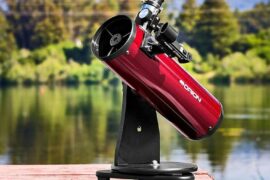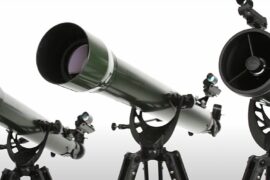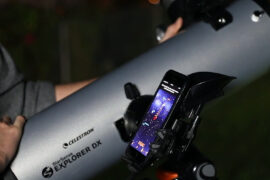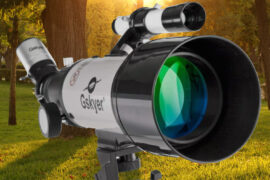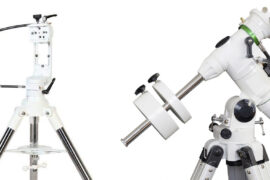In technology, when you have a clear leader when it comes to brand recognition, it is important to constantly test and compare their products to make sure they are keeping the quality standards that gained them their good reputation in the first place.
In this guide, I’m going to do exactly that with Celestron, the company originally founded in California that is currently the market share leader in the United States. I am going to specifically take a look at their eyepiece lineup that contains a wide range of products, from entry-level budget pieces to the ones that cost more than many telescopes.
Note: Throughout the article “EP” will be used as an abbreviation for eyepiece.
If you just want to skip to the picks, click the button below.
Methodology
I’ve had the chance to personally test all of these eyepieces myself thanks to friends and my local astronomy group. I own a couple of them myself because as some of you may know, my main telescope is a Celestron Advanced VX SCT so these match very well both in quality and looks.
I compared each eyepiece with competitors in a similar price and quality range. For example, I compared the X-Cel to the Meade HD-60 series which has pretty much the same specifications.
As for the telescopes used, a Celestron VX SCT, a Meade Polaris 114 reflector, and an Orion Observer 90mm refractor were used so I could test them with a wide range of telescope brands and apertures.
Are Celestron eyepieces good?
Yes. Celestron gear is generally worth the money. This includes their eyepieces. Their product lineup is all-around solid, high quality, and fairly priced.
One thing I really like about Celestron products is they always try to have one feature that makes them stand out when compared to their direct competitors. For example, the Luminos line offers an 82° field of view which is generally only available on eyepieces one or two price tiers higher.
Industrial design is one of the features that make Celestron stand out. All their products have a distinct aesthetic and a recognizable color palette. You can generally tell when a telescope or an accessory is a Celestron without looking at the logo. Their products just look better than everything else on the market. Whether you like their design or not is entirely subjective, and some people don’t care for it and they merely focus on functionality, but I think we can all agree that they are the brand that puts the most work into those details and if the design is something that matters to you, then Celestron items should be at the top of your list of options.
The optics quality of Celestron eyepieces ranges from good to great. They are not the top performers like a Televue or a Baader, but they are definitely above average.
The price to quality ratio is good although some people believe they are slightly overpriced because you are paying a little bit extra for the cool designs.
How to choose which eyepiece to buy
The first thing to think about when choosing a new eyepiece is “what function is it going to serve?”. Do you need it because the ones that came with your telescope are low quality and you need to upgrade? do you need one that gives you a better view of planets? or one that covers a specific magnification you don’t have yet?.
With that in mind, you can define the features you need. Specifically focal length and field of view. If you are just getting started in the hobby and you don’t know or care what the numbers mean, our picks below are selected for the use cases they are better at, for example, “best for looking at galaxies or deep space objects”.
So let’s take a look at what you need to look at when getting a new eyepiece.
Focal length
This is the first number you will see when looking at an eyepiece. It is given in millimeters (mm) and goes from 5mm to 40mm. It refers to the distance the light needs to travel from the entry to the exit point of the EP.
The focal length has an inverse relationship with the magnification you´ll get. This means that a lower focal length will result in higher magnification and a high focal length will result in lower magnification.
Magnification
Every telescope has a minimum and a maximum magnification it can support. It is determined by its aperture. Any magnification above or below that range won´t result in any changes or it might even yield a blurry image.
The maximum magnification can be estimated by multiplying the aperture in millimeters by 2 (some people say 2.5 but that’s a stretch in my experience). So for example, if you have a Celestron Astromaster 130EQ that has an aperture of 130mm you can get its highest useful magnification by multiplying:
130 x 2 = 260x
Using the same example, the Astromaster has a focal length of 650mm, so we can calculate what eyepieces it can use by using the magnification formula (magnification = telescope focal length/eyepiece focal length):
260 = 650 / x
x = 650/260 = 2.5
That means the Astromaster can use eyepieces of 2.5mm and higher. Since the smaller models only really get to 3.5mm, that means you can pretty much use any EP on the market.
Take a look at your collection
Knowing the universe of eyepieces that your telescope can use you can now take a look at your collection and see what’s missing.
Most telescopes come with a couple of EPs to cover the mid and low magnification.
Continuing with the example above, the Astromaster comes with a 10mm and a 20mm. That means that you could benefit from getting a high magnification option, like a 5mm if you want to focus on planetary viewing, or maybe a low magnification wide-field 32 mm that could get you great views on deep space objects and would have the added benefit of covering the middle point of the other two eyepieces if you have to add 2x Barlow lens as it would effectively be like also having a 16mm.
Best Celestron eyepiece for planets: X-Cel LX Series
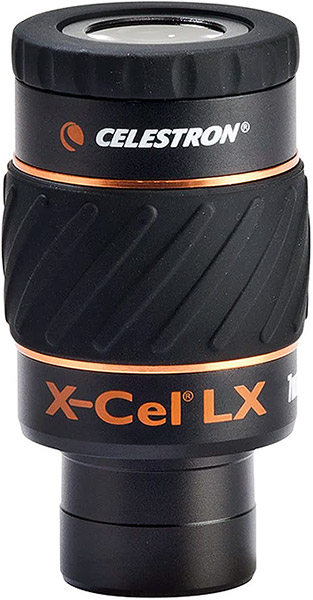
| Model | X-Cel Series |
| Barrel size | 1.25″ |
| Focal length | 2.3mm, 5mm, 7mm, 9mm, and others |
| Field of view | 60° |
| Mirrors (elements) | 6 |
| Price |
I have talked in-depth about this in our article about the eyepieces to view planets but in short, when it comes to choosing one for planetary viewing, the main concern should be high magnification.
Planets and the Moon are the objects where you can max out and test the highest levels of magnification your telescope can reach. For this, you will need a low focal length and this series has four different options below 10mm, including a 2.3mm eyepiece that loos spectacular if your device can support such high zoom.
For planetary viewing, some people also like a narrow field of view. I disagree a little bit as in my experience it just makes it harder to keep the planet centered so I prefer a larger FoV like the 60° the X-Cel series has.
The X-Cel will be a very significant upgrade over any bundled eyepiece. It’s a 6-element design, which means the light transmission, sharpness, and contrast are much better than your usual Kellner or Plossl (which have 3 and 4 elements respectively).
I believe the outer shell and design of Celestron EPs are even better than some of the more premium brands. They put a lot of thought into improving how you handle the piece and it shows in the rubber eyeguards and treaded grip of this design. It seems like something irrelevant as it’s not something that makes the images better, but it does improve a lot your overall stargazing experience.
Best Celestron eyepiece for galaxies and DSOs: Luminos series
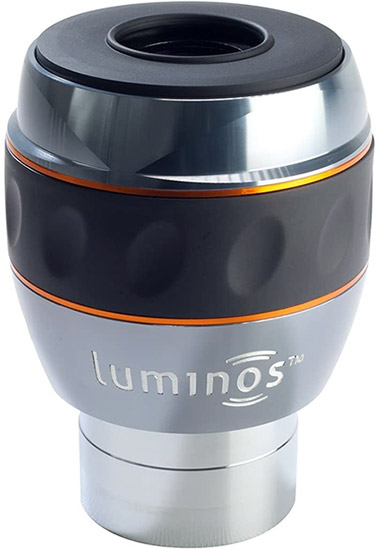
| Model | Luminos Series |
| Barrel size | 1.25″ |
| Focal length | 19mm, 23mm, 31mm, others |
| Field of view | 82° |
| Mirrors (elements) | 6 or 7 depending on the model |
| Price |
Unlike planetary viewing, for galaxy and deep space object watching, a wide field of view is crucial. Galaxies and nebulas are much better appreciated as a whole and a large FoV allows you to do just that.
You will also want to use eyepieces that have lower levels of magnification. That means using larger focal lengths. In general, you want to use eyepieces of 20mm and above although these kinds of rules always have exceptions.
The Celestron Luminos series is built exactly with these specs in mind. It has an ultra-wide 82° field of view and most of its models are above the 19mm range.
The main design feature that gives the Luminos its unique look is its retractable eyecup that pops when you need it and can retract when you don’t. The marketing photos of the Luminos don’t prepare you for how big it really is. This thing is huge. It is by far the biggest eyepiece I have ever tested, and I have tested a lot. Some people love this riskier design while some think it’s a bit too much. That’s a very subjective choice.
The inner design of the Luminos uses 6 or 7 elements depending on the model. This makes the optics extremely high quality. I was not able to notice any of the common optical errors and brightness and contrast were as good as you can expect from such a premium product.
The price of the Luminos is high when compared to most eyepieces, however, it should be noted that it is definitely a premium model competing in the ultra-wide market with the likes of the Televue Naglers that are priced even higher.
Best Celestron Budget Eyepiece: Omni Series
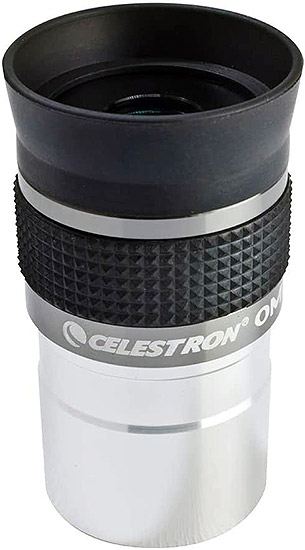
| Model | Omni Series |
| Barrel size | 1.25″ |
| Focal length | 4mm to 40mm |
| Field of view | 50° |
| Mirrors (elements) | 4 |
| Price |
If you are looking for something much simpler that offers all-around solid performance and doesn’t break the bank, then the Celestron Omni is for you.
The Omni series uses a Plossl 4-element design that is extremely popular because it meets the right between price and value. If your telescope came with Kellner eyepieces or some other basic design, then this will be an upgrade.
On the other hand, if it already came with Plossl EPs, then the Omni would be almost a lateral move and I wouldn’t recommend them as a replace them, but they would still be a great complement to fill any focal length sizes you don’t have yet.
A couple of these Omnis and the Barlow lens from the same line (check out our review) are common recommendations when people just getting into the hobby ask what eyepieces they need to start a solid collection.
The Omni has models from 4mm all the way to 40mm.
The aluminum design and outer build are sturdy and high quality. The optics are solid. Overall the Omni line offers good performance at a great price.
Best Celestron eyepiece for astrophotography: Ultima Edge series
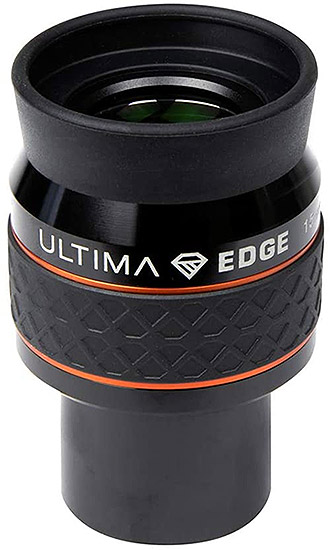
| Model | Omni Series |
| Barrel size | 1.25″ |
| Focal length | 10mm to 24mm |
| Field of view | 60° – 65° depending on the model |
| Mirrors (elements) | 5 or 8 depending on the model |
| Price |
The normal design for an eyepiece mirror results in a “curved” field of view. In practical terms, this means the edges of the image lose a little bit of quality. While this isn’t really a problem and is barely noticeable when you are looking through a telescope, it does matter more when it comes to astrophotography.
The Ultima Edge is Celestron’s solution to this issue. It’s a wide (60°-65°) parfocal “ultra-flat” eyepiece that promises to keep the same level of sharpness from the center of the image to the very edge.
It achieves this by using a complex proprietary design that uses between 5 and 8 elements depending on the model.
It has the added benefit of having a very generous eye relief, making it also a very attractive option for glass-wearers.
It is available in models from 10mm to 24mm for 1.25″ barrels and there’s a 30mm model that is only available for 2″ slots.
The price of the Ultima Edge is high when compared to EPs of similar image quality so I wouldn’t recommend it unless it is for very specific use-cases like astrophotography where you really want to maximize crispness and you are looking to get every edge (pun intended) you can get.
Summary
- Celestron EPs are generally worth investing into
- The best model is going to depend on your particula use-case
- Their eyepiece have a solid price to value ratio and unique features
Enjoyed this article?
Get daily 10-minute PDFs about astronomy to read before bed!
Sign up for our upcoming micro-learning service where you will learn something new about space and beyond every day while winding down.


